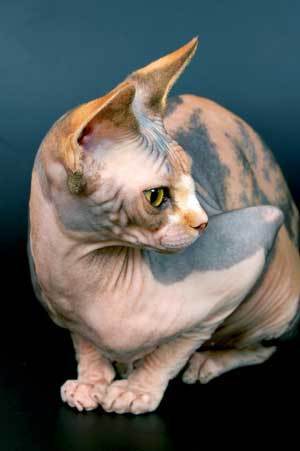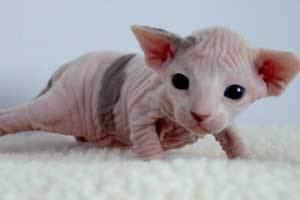 Breed Description: The Sphynx is immediately recognizable for its wrinkled skin and lack of hair. It has a long arched back and whip-like tail, long legs and a head featuring huge ears and large, expressive eyes. In many ways, the Sphynx has a body similar to the Cornish or Devon Rex, except that it lacks hair.
Breed Description: The Sphynx is immediately recognizable for its wrinkled skin and lack of hair. It has a long arched back and whip-like tail, long legs and a head featuring huge ears and large, expressive eyes. In many ways, the Sphynx has a body similar to the Cornish or Devon Rex, except that it lacks hair.History & Origin: The Aztecs were known to have hairless cats like the Sphynx (and hairless dogs) centuries ago, yet the exact origins of this breed are still unknown. The gene responsible for the absence of their coat is recessive, so unless both adult cats carry the gene, it may be passed down through many generations before it appears in offspring.
Character & Temperament: The Sphynx make a wonderful companion for people who aren't away a lot. They establish close bonds with their people and do not enjoy being separated from them-even if left with a companion. They need lots of attention and may get literally heartsick if feeling lonely or neglected. This breed seems to lack aggression and has a very friendly and social nature. The Sphynx has a unique ability to use its paws like hands. Combined with an inquisitive nature, they will work open any doors and cupboards left unsecured. These cats are happy indoors, but are playful and active and need to scratch and climb.
Color: All colors and patterns, in any combination.
Coat Type: Very fine downy hairs.
Grooming: Despite being almost hairless, the Sphynx requires regular bathing (every two weeks) to remove the grease that would normally be absorbed by hair. Intact males need even more frequent bathing. This breed's ears also get dirtier than other breeds and need more frequent cleaning. Claws should be trimmed as necessary.
Health Considerations: This breed is hardy and has no serious inherited breed-related problems.
Trivia: Unlike hairless dogs, the Sphynx does not seem to be affected by UV rays. Its color actually intensifies in the sun. In the summer in warmer climates they may develop freckles.
This page contains the following solutions.
Hairless cats aren't totally hairless. Like a peach, they've got fuzz. Down, if you will. The sensation of touching a hairless cat has been compared to warm velvet, or a hot water bottle.